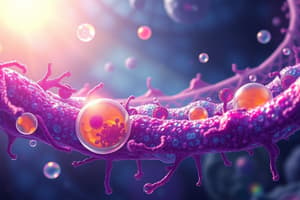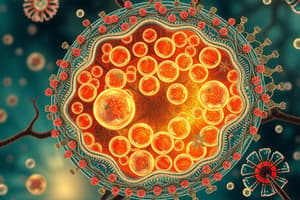Podcast
Questions and Answers
What is the primary function of membranes in a cell?
What is the primary function of membranes in a cell?
- Storing genetic information
- Executing transport, enzyme activity, and cell communication (correct)
- Supporting the cell's structure
- Regulating cell growth and division
Which type of lipid molecule is most abundant in membranes?
Which type of lipid molecule is most abundant in membranes?
- Triacylglycerols
- Phospholipids (correct)
- Cholesterol
- Sphingolipids
What is the estimated frequency of lateral movement in the plasma membrane?
What is the estimated frequency of lateral movement in the plasma membrane?
- Once per minute
- 100000 times per second
- 100000000 times per second (correct)
- Once per hour
What is the primary reason for the fluidity of membranes?
What is the primary reason for the fluidity of membranes?
What is the characteristic of the plasma membrane in terms of its composition?
What is the characteristic of the plasma membrane in terms of its composition?
What is the estimated number of different types of lipids found in membranes?
What is the estimated number of different types of lipids found in membranes?
What is the primary function of clathrin-positive compartments and vesicles in the cell?
What is the primary function of clathrin-positive compartments and vesicles in the cell?
What is the thickness of most membranes in the cell?
What is the thickness of most membranes in the cell?
What is the characteristic of the movement of lipids in the membrane?
What is the characteristic of the movement of lipids in the membrane?
What is the composition of the membrane in terms of lipids and proteins?
What is the composition of the membrane in terms of lipids and proteins?
Which type of molecules can dissolve in the lipid bilayer and pass through the membrane rapidly?
Which type of molecules can dissolve in the lipid bilayer and pass through the membrane rapidly?
What is the primary function of the Na+/K+ pump in animal cells?
What is the primary function of the Na+/K+ pump in animal cells?
What is the role of clathrin molecules in the cell?
What is the role of clathrin molecules in the cell?
What is the function of post-translational modifications of proteins?
What is the function of post-translational modifications of proteins?
What is the primary function of motor proteins in the cell?
What is the primary function of motor proteins in the cell?
What is the function of the nuclear pore complex?
What is the function of the nuclear pore complex?
What is the role of myosin motor proteins in muscle contraction?
What is the role of myosin motor proteins in muscle contraction?
What is the function of chromatophores in cephalopods?
What is the function of chromatophores in cephalopods?
What is the primary function of the Golgi body in protein synthesis?
What is the primary function of the Golgi body in protein synthesis?
What is the function of ubiquitination in protein degradation?
What is the function of ubiquitination in protein degradation?
What is the primary mechanism by which cells regulate their intracellular osmolarity?
What is the primary mechanism by which cells regulate their intracellular osmolarity?
What is the role of glycosylation in protein targeting?
What is the role of glycosylation in protein targeting?
What is the primary function of the nuclear envelope?
What is the primary function of the nuclear envelope?
What is the primary function of myosin motor proteins in cells?
What is the primary function of myosin motor proteins in cells?
What is the primary mechanism of protein transport through the nuclear pore complex?
What is the primary mechanism of protein transport through the nuclear pore complex?
What is the primary function of the Na+/K+ pump in animal cells?
What is the primary function of the Na+/K+ pump in animal cells?
What is the primary mechanism of vesicle transport in cells?
What is the primary mechanism of vesicle transport in cells?
What is the primary function of the Golgi body in protein synthesis?
What is the primary function of the Golgi body in protein synthesis?
What is the primary mechanism of osmosis in cells?
What is the primary mechanism of osmosis in cells?
What is the primary function of phosphorylation in protein targeting?
What is the primary function of phosphorylation in protein targeting?
What is the primary function of membranes in terms of cell communication?
What is the primary function of membranes in terms of cell communication?
What is the characteristic of membrane-bound ribosomes in terms of protein synthesis?
What is the characteristic of membrane-bound ribosomes in terms of protein synthesis?
What is the key difference between bacterial membranes and animal cell membranes?
What is the key difference between bacterial membranes and animal cell membranes?
What is the primary function of phospholipids in membranes?
What is the primary function of phospholipids in membranes?
What is the result of the asymmetrical structure of the plasma membrane?
What is the result of the asymmetrical structure of the plasma membrane?
What is the role of non-covalent bonds in maintaining membrane fluidity?
What is the role of non-covalent bonds in maintaining membrane fluidity?
What is the characteristic of the movement of lipids in the plasma membrane?
What is the characteristic of the movement of lipids in the plasma membrane?
What is the function of enveloped viruses in terms of membrane composition?
What is the function of enveloped viruses in terms of membrane composition?
What is the result of the variation in head groups, hydrocarbon chain lengths, and saturation states of phospholipids?
What is the result of the variation in head groups, hydrocarbon chain lengths, and saturation states of phospholipids?
What is the characteristic of the composition of membranes in terms of lipids and proteins?
What is the characteristic of the composition of membranes in terms of lipids and proteins?
Flashcards are hidden until you start studying
Study Notes
Cell Membranes and Compartments
- Cell membranes are sheet-like structures, 2 molecules thick, forming closed boundaries, typically 5-10 nm thick.
- Membranes are composed of lipids and proteins, with approximately 50 lipid molecules per protein in a plasma membrane.
- Phospholipids are the most abundant membrane lipids, with 500-1000 different types identified, varying in head groups, hydrocarbon chain lengths, and saturation states.
Membrane Structure and Function
- The plasma membrane is asymmetrical, with lateral movement occurring around 100 million times per second and flip-flop movement less than once per month.
- Membrane fluidity depends on non-covalent bonds, membrane composition, and temperature.
- The plasma membrane regulates molecular traffic, allowing hydrophobic molecules like hydrocarbons to dissolve in the lipid bilayer and pass through rapidly.
Cellular Compartmentalization
- Cells are compartmentalized, with separate regions for different functions, and busy with various activities.
- The amino acid sequence of a protein contains instructions for its cellular location.
- Post-translational modifications like glycosylation, phosphorylation, and ubiquitination affect protein location and function.
Protein Transport
- There are three main ways to transport proteins: gated transport (nuclear pore), transmembrane transport (mitochondria), and vesicular transport (motor proteins).
- The nuclear envelope consists of two concentric membranes with nuclear pores, importing proteins and exporting mRNA.
Motor Proteins and Vesicle Transport
- Three types of motor proteins (myosin, kinesin, and dynein) transport vesicles along actin microfilaments and microtubules, requiring ATP energy.
- Motor proteins also play a role in muscle contraction and cell movement.
- In some organisms, motor proteins transport pigment molecules along microtubules to change color and adapt to environmental conditions.
Studying That Suits You
Use AI to generate personalized quizzes and flashcards to suit your learning preferences.




